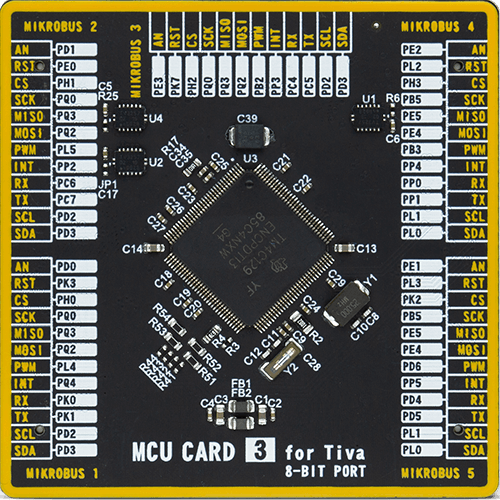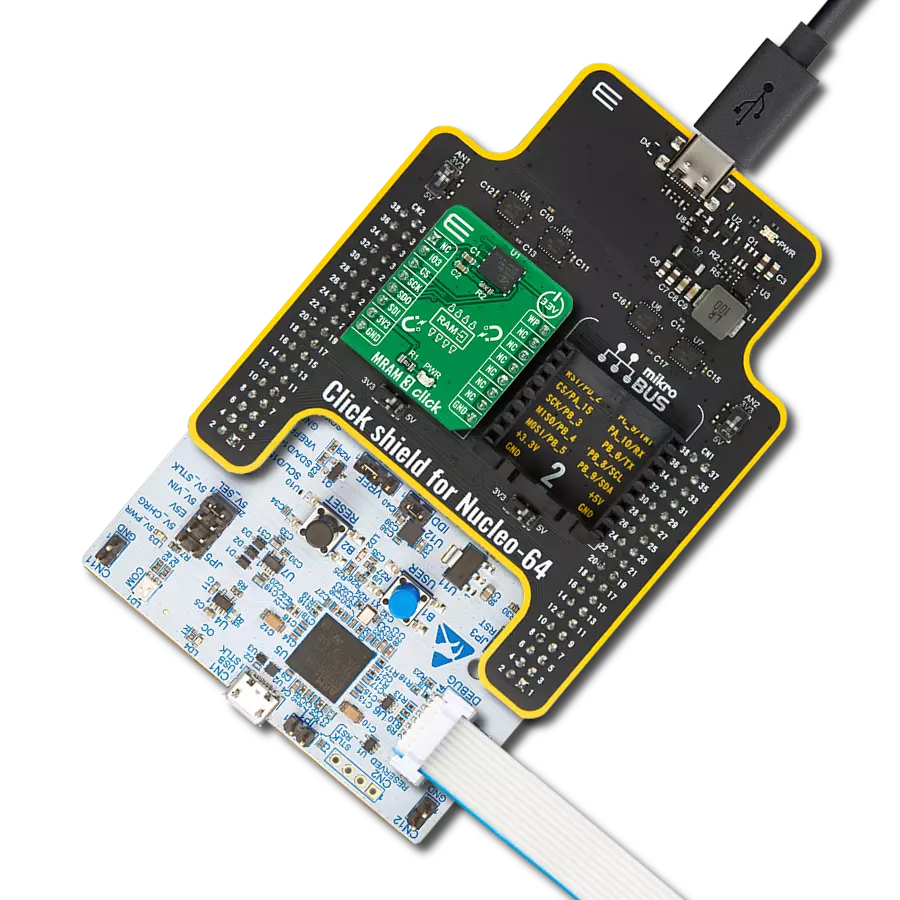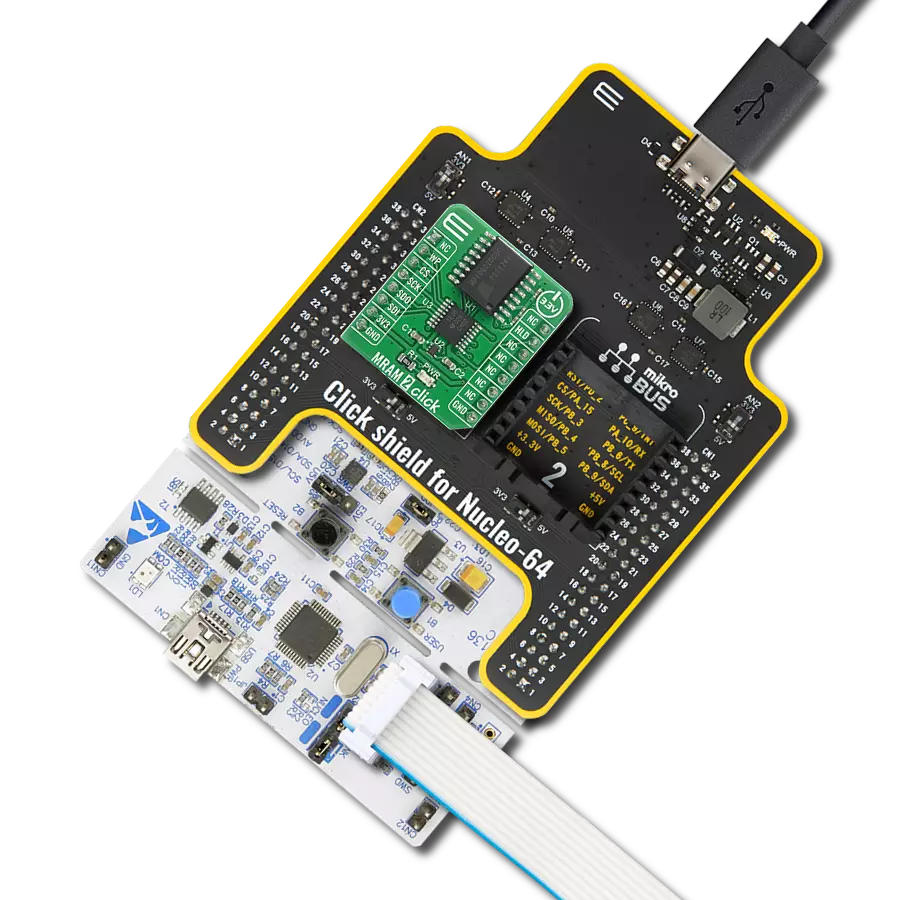Our MRAM memory solution sets a new standard in data storage technology, combining rapid access speeds with magnetic reliability for a seamless and efficient user experience.
A
A
Hardware Overview
How does it work?
MRAM 4 Click is based on the EM064LX, an industrial STT-MRAM persistent memory from Everspin Technologies. It can deliver up to 400Mbps reads and writes via eight I/O signals with a clock frequency of 200MHz. As this is a persistent memory, byte-level writes and reads do not require erasing. Nonvolatile settings are not reflow protected, which you have to keep in mind. A dedicated 256-byte OTP area outside the main memory is readable and user-lockable, with a permanent lock WRITE OTP command. The EM064LX is capable of chip/bulk and sector erase. Subsector erase is possible in 4KB, 32KB granularity. In addition, the MRAM memory features 16 configurable hardware write-protected
regions plus top/bottom select, program/erase protection during power-up, and CRC command to detect accidental changes to user data. As the EM064LX works at the recommended 1.8V voltage, the MRAM 4 Click is equipped with a BH18PB1WHFV, a CMOS LDO regulator from Rohm Semiconductor. To work with different logic level voltage, this Click board™ comes with a TXB0106, a 6-bit bidirectional level-shifting and voltage translator from Texas Instruments. On board, there are two unpopulated jumpers labeled R5 and R6. The chip select and write protection can be pulled up for further hardware development. MRAM 4 Click uses a standard 4-Wire SPI serial interface to communicate
with the host MCU. You can use write protection functionality over the WP pin. The hardware reset is available over the HLD pin, whereas in the low logic state, the memory will self-initialize and return the device to the ready state. There is an unpopulated R6 resistor for an external pull-up, as this pin shouldn’t be allowed to float. This Click board™ can be operated only with a 3.3V logic voltage level. The board must perform appropriate logic voltage level conversion before using MCUs with different logic levels. Also, it comes equipped with a library containing functions and an example code that can be used as a reference for further development.
Features overview
Development board
Fusion for TIVA v8 is a development board specially designed for the needs of rapid development of embedded applications. It supports a wide range of microcontrollers, such as different 32-bit ARM® Cortex®-M based MCUs from Texas Instruments, regardless of their number of pins, and a broad set of unique functions, such as the first-ever embedded debugger/programmer over a WiFi network. The development board is well organized and designed so that the end-user has all the necessary elements, such as switches, buttons, indicators, connectors, and others, in one place. Thanks to innovative manufacturing technology, Fusion for TIVA v8 provides a fluid and immersive working experience, allowing access
anywhere and under any circumstances at any time. Each part of the Fusion for TIVA v8 development board contains the components necessary for the most efficient operation of the same board. An advanced integrated CODEGRIP programmer/debugger module offers many valuable programming/debugging options, including support for JTAG, SWD, and SWO Trace (Single Wire Output)), and seamless integration with the Mikroe software environment. Besides, it also includes a clean and regulated power supply module for the development board. It can use a wide range of external power sources, including a battery, an external 12V power supply, and a power source via the USB Type-C (USB-C) connector.
Communication options such as USB-UART, USB HOST/DEVICE, CAN (on the MCU card, if supported), and Ethernet is also included. In addition, it also has the well-established mikroBUS™ standard, a standardized socket for the MCU card (SiBRAIN standard), and two display options for the TFT board line of products and character-based LCD. Fusion for TIVA v8 is an integral part of the Mikroe ecosystem for rapid development. Natively supported by Mikroe software tools, it covers many aspects of prototyping and development thanks to a considerable number of different Click boards™ (over a thousand boards), the number of which is growing every day.
Microcontroller Overview
MCU Card / MCU

Type
8th Generation
Architecture
ARM Cortex-M4
MCU Memory (KB)
1024
Silicon Vendor
Texas Instruments
Pin count
128
RAM (Bytes)
262144
Used MCU Pins
mikroBUS™ mapper
Take a closer look
Click board™ Schematic

Step by step
Project assembly
Software Support
Library Description
This library contains API for MRAM 4 Click driver.
Key functions:
mram4_memory_write- MRAM 4 memory write function.mram4_memory_read- MRAM 4 memory read function.mram4_block_erase- MRAM 4 block erase function.
Open Source
Code example
The complete application code and a ready-to-use project are available through the NECTO Studio Package Manager for direct installation in the NECTO Studio. The application code can also be found on the MIKROE GitHub account.
/*!
* @file main.c
* @brief MRAM 4 Click example
*
* # Description
* This example demonstrates the use of MRAM 4 Click board.
* The demo app writes specified data to the memory and reads it back.
*
* The demo application is composed of two sections :
*
* ## Application Init
* The initialization of SPI module, log UART, and additional pins.
* After the driver init, the app executes a default configuration.
*
* ## Application Task
* The demo application writes a desired number of bytes to the memory
* and then verifies if it is written correctly
* by reading from the same memory location and displaying the memory content.
* Results are being sent to the UART Terminal, where you can track their changes.
*
* @author Nenad Filipovic
*
*/
#include "board.h"
#include "log.h"
#include "mram4.h"
static mram4_t mram4;
static log_t logger;
#define STARTING_ADDRESS 0x012345ul
#define DEMO_TEXT_MESSAGE_1 "MikroE"
#define DEMO_TEXT_MESSAGE_2 "MRAM 4 Click"
void application_init ( void )
{
log_cfg_t log_cfg; /**< Logger config object. */
mram4_cfg_t mram4_cfg; /**< Click config object. */
/**
* Logger initialization.
* Default baud rate: 115200
* Default log level: LOG_LEVEL_DEBUG
* @note If USB_UART_RX and USB_UART_TX
* are defined as HAL_PIN_NC, you will
* need to define them manually for log to work.
* See @b LOG_MAP_USB_UART macro definition for detailed explanation.
*/
LOG_MAP_USB_UART( log_cfg );
log_init( &logger, &log_cfg );
log_info( &logger, " Application Init " );
// Click initialization.
mram4_cfg_setup( &mram4_cfg );
MRAM4_MAP_MIKROBUS( mram4_cfg, MIKROBUS_1 );
if ( SPI_MASTER_ERROR == mram4_init( &mram4, &mram4_cfg ) )
{
log_error( &logger, " Communication init." );
for ( ; ; );
}
if ( MRAM4_ERROR == mram4_default_cfg ( &mram4 ) )
{
log_error( &logger, " Default configuration." );
for ( ; ; );
}
Delay_ms ( 100 );
log_info( &logger, " Application Task " );
log_printf( &logger, "-----------------------\r\n" );
Delay_ms ( 100 );
}
void application_task ( void )
{
uint8_t data_buf[ 128 ] = { 0 };
log_printf( &logger, " Memory address: 0x%.6LX\r\n", ( uint32_t ) STARTING_ADDRESS );
if ( MRAM4_OK == mram4_block_erase( &mram4, MRAM4_CMD_ERASE_4KB, STARTING_ADDRESS ) )
{
log_printf( &logger, " Erase memory block (4KB)\r\n" );
Delay_ms ( 100 );
}
memcpy( data_buf, DEMO_TEXT_MESSAGE_1, strlen( DEMO_TEXT_MESSAGE_1 ) );
if ( MRAM4_OK == mram4_memory_write( &mram4, STARTING_ADDRESS, data_buf, sizeof( data_buf ) ) )
{
log_printf( &logger, " Write data: %s\r\n", data_buf );
Delay_ms ( 100 );
}
memset( data_buf, 0, sizeof( data_buf ) );
if ( MRAM4_OK == mram4_memory_read( &mram4, STARTING_ADDRESS, data_buf, sizeof( data_buf ) ) )
{
log_printf( &logger, " Read data: %s\r\n", data_buf );
Delay_ms ( 1000 );
Delay_ms ( 1000 );
Delay_ms ( 1000 );
}
log_printf( &logger, " ----------------------------\r\n" );
log_printf( &logger, " Memory address: 0x%.6LX\r\n", ( uint32_t ) STARTING_ADDRESS );
if ( MRAM4_OK == mram4_block_erase( &mram4, MRAM4_CMD_ERASE_4KB, STARTING_ADDRESS ) )
{
log_printf( &logger, " Erase memory block (4KB)\r\n" );
}
memcpy( data_buf, DEMO_TEXT_MESSAGE_2, strlen( DEMO_TEXT_MESSAGE_2 ) );
if ( MRAM4_OK == mram4_memory_write( &mram4, STARTING_ADDRESS, data_buf, sizeof( data_buf ) ) )
{
log_printf( &logger, " Write data: %s\r\n", data_buf );
Delay_ms ( 100 );
}
memset( data_buf, 0, sizeof( data_buf ) );
if ( MRAM4_OK == mram4_memory_read( &mram4, STARTING_ADDRESS, data_buf, sizeof( data_buf ) ) )
{
log_printf( &logger, " Read data: %s\r\n", data_buf );
Delay_ms ( 1000 );
Delay_ms ( 1000 );
Delay_ms ( 1000 );
}
log_printf ( &logger, " ----------------------------\r\n" );
}
int main ( void )
{
/* Do not remove this line or clock might not be set correctly. */
#ifdef PREINIT_SUPPORTED
preinit();
#endif
application_init( );
for ( ; ; )
{
application_task( );
}
return 0;
}
// ------------------------------------------------------------------------ END
































